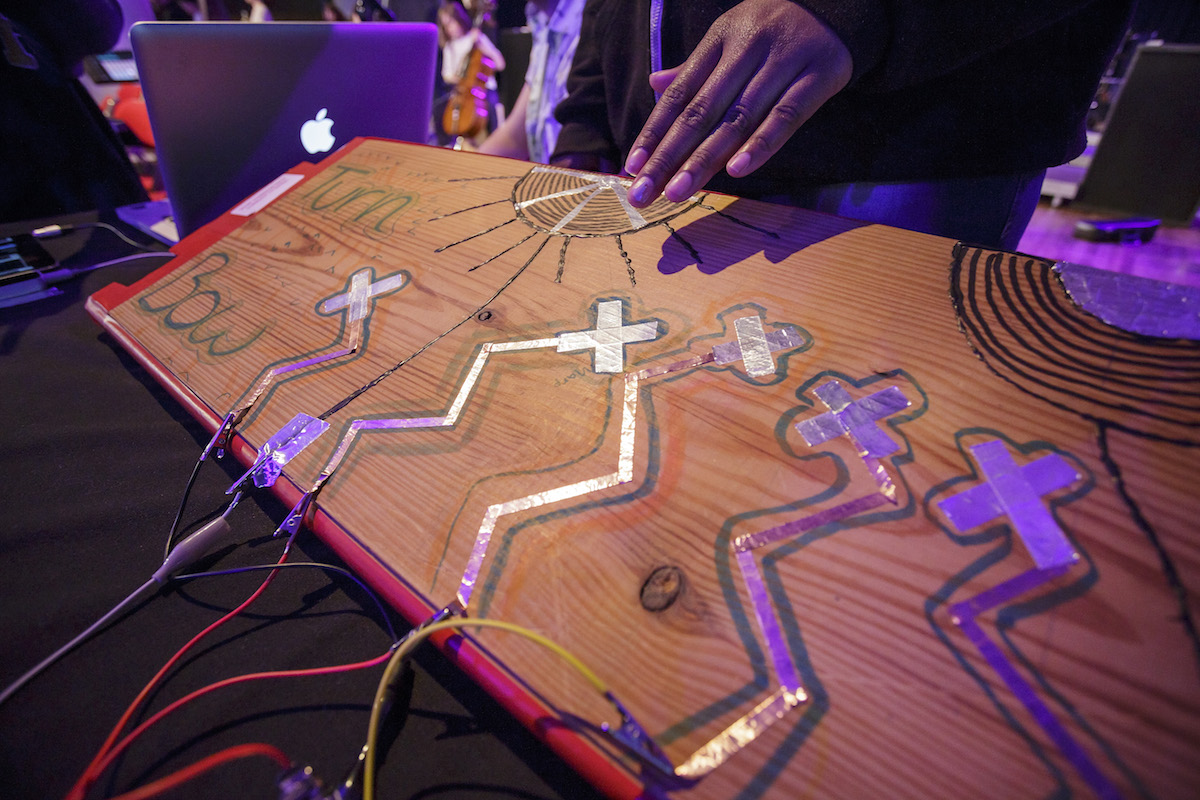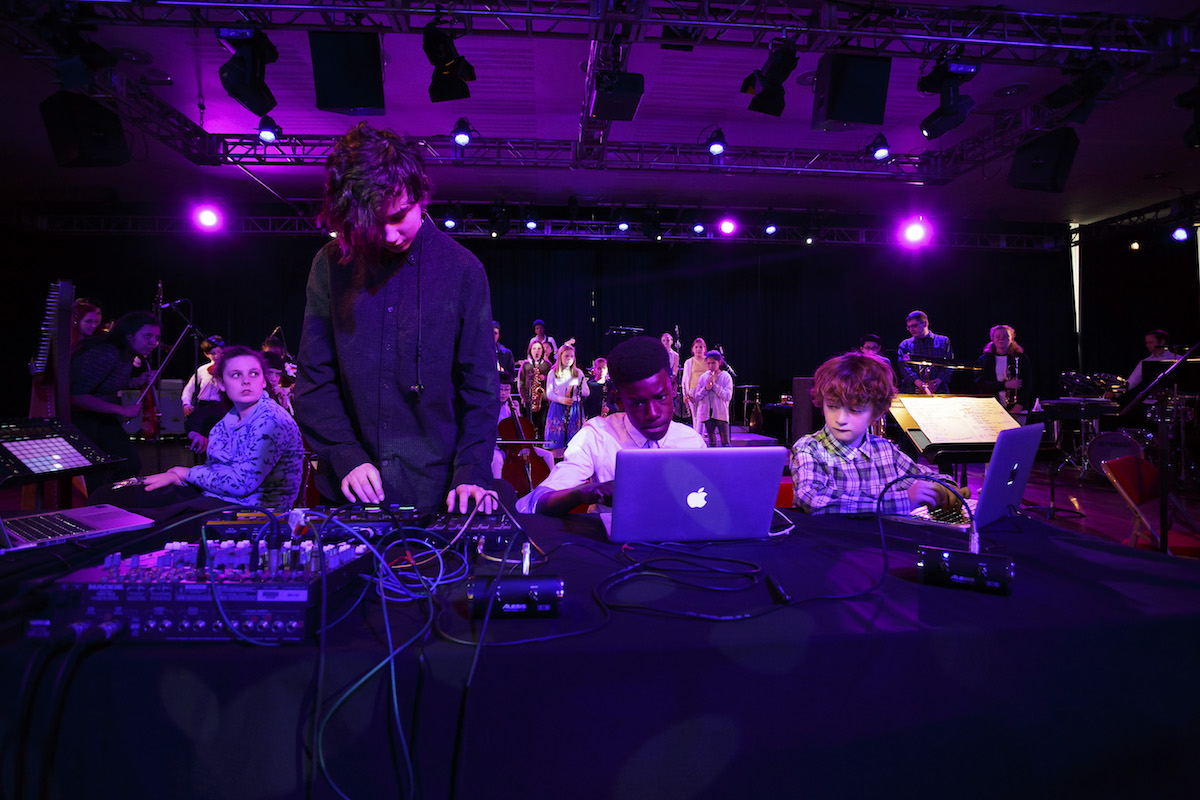A partnership between Trinity Laban Conservatoire of Music and Dance, the London Philharmonic Orchestra and the Music Education Hubs in Lambeth, Lewisham, Royal Greenwich and Southwark.
Short description
Animate Orchestra is a 'Young People's Orchestra for the 21st Century'. It is a partnership between Trinity Laban Conservatoire of Music and Dance, the London Philharmonic Orchestra and the Music Education Hubs in Lambeth, Lewisham, Royal Greenwich and Southwark. It was founded in 2011 to address the ‘danger point’ of young people discontinuing their instrumental learning through the transition from primary to secondary school.

What are the goals of the work?
The goals of the work are:
- To provide creative ensemble music making opportunities as a local progression route for young musicians;
- To motivate continued instrumental learning;
- To demonstrate the power and impact of the orchestra in an ensemble that represents the ideas and culture of a new generation;
- To inspire young people through access to live professional musicianship and performance opportunities with high production values; and
- To represent the diverse talents and ideas of children and young people, with opportunities for individuals to develop their roles and to gain Arts Award accreditation.
What is the context of the work?
- Students live or go to school in the London Boroughs of Lambeth, Lewisham, Royal Greenwich and Southwark and are in School Years 5 to 13. They participate at three levels:
- Animate Local (provided by the Music Hubs in Lewisham, Greenwich, Lambeth and Southwark);
- Animate Performing Ensembles (Years 5-10); and
- Animate Artists (Years 8-13).
- Animate Local activities take place either on Saturdays for 1-2 hours (Greenwich and Southwark Music Hub Centres), or during half-term holidays for 1-2 days (Lambeth and Lewisham Music Hubs).
- Performing Ensembles (3-day courses followed by a performance) and Animate Artists (taking place over a 4-month period) take place during school holidays and on Sundays, usually in secondary schools across the four boroughs, but sometimes at Trinity Laban Conservatoire of Music and Dance.
- Animate courses welcome players of any instrument, including music technology, and of any level of ability at entry to Animate Local. Entry to the Performing Ensembles and Animate Artists is by invitation, based either on participation in Animate Local activities, or through an Animate Experience Day.
- Young people are supported to attend additional cultural opportunities through Animate’s Backstage scheme – e.g. concert trips and collaborative summer holiday projects with organisations such as British Film Institute and the Royal Academy of Art.
- Membership is diverse in terms of gender, ethnicity and socio-economic background. In 2014-15, 58% of young people who disclosed ethnicity were BAME participants.
- 15% access Free School Meals, and an analysis of home postcode against an index of deprivation found significant recruitment coming from the most deprived areas.
- Animate Orchestra has been running since 2011. During 2014 – 2015, 482 young people participated in Animate activities.
- September 2015 saw the introduction of the top tier – Animate Artists, and a CPD programme for music hub tutors to support them in delivering the Animate Local activities.
- Recruitment and taster workshops take place during the Summer tem to encourage and support under-represented groups to participate in Animate Orchestra.
- Animate Local activities are led by music hub tutors from the partner Music Education Hubs, supported and mentored through the Animate Local CPD programme by Animate Orchestra’s Learning Director and Creative Directors.
- Animate Performing Ensembles and Animate Artists projects are led by the Creative Directors, Jason Rowland and Sarah Freestone. They are supported by musicians from the London Philharmonic Orchestra, musicians and students from Trinity Laban and Animate Local tutors from the Music Education Hubs.
What is the content of the work?
- Members devise, compose and perform music of their own creation from memory, with each participant supported at their own level. Improvisation, composition tasks and playing in an ensemble are integrated and made accessible from the earliest stages of musical learning. The aim is to achieve the highest musical standards and also to reflect the ideas and cultural aspirations of our members.
- All new music is inspired by wide-ranging genres of existing repertoire. Young people listen, analyse and appraise the repertoire before using some of the focus composer’s techniques and styles to create their own new music.
- Young musicians develop instrumental skills, creativity, ensemble skills and musicianship in a series of progressively challenging ensembles .
- Young musicians progress through the ensembles based on their contribution of new ideas and their creativity, not solely on instrumental ability.
- Animate Orchestra has a group of music technologists who form one section of the orchestra, along with wind, strings, brass and ‘others’ (keyboards, guitars, ukuleles, bass guitars, percussion). Music technologists build their own instruments, and make their music recording and manipulating sounds both from within and outside of the orchestra.
- Animate Local activities culminate in informal sharing events for parents. Performing Ensemble and Animate Artists projects culminate in high profile performance events at prestigious venues such as Royal Festival Hall, Royal Albert Hall and the Bonnie Bird Theatre.
What are the key features of the teaching and learning approach?
According to an independent evaluation of the programme, Chris Philpott’s Locating the Pedagogies in Animate Orchestra, May 2015 reported the following pedagogical features of Animate activites:
- There is a strong emphasis on the ‘aural’ dimension to making music, with little or no recourse to notation (which is an innovative deviation from the typical model of the local youth orchestra).
- Children and young people are expected to behave as disciplined and creative musicians and the tutors consistently model this musical behaviour and their own creativity—the concept of the ‘orchestra’ provides a very strong framework here.
- The hugely committed workshop leaders are expert managers of a large group of children in this ‘aural’ approach to musical learning and are well supported by expert professional musicians and teachers.
- As a result of their engagement with the music (usually an orchestral piece chosen as stimulus for the project), the expert tutors and the activities, the children and young people make significant musical progress, especially in relation to developing the technical and aural skills of bringing together a complicated and intricate structure that requires considerable memorisation.
- The pedagogy of the project is strongly framed through the orchestral format, the workshop leaders, the ‘set piece’ chosen as a stimulus and by the interventions of the tutors. The upshot is that, on balance, the creative and musical choices made by the children are also strongly framed by the same and the pedagogy could be characterised as being predominantly tutor-led.
How is the work being reviewed?
- Animate Orchestra commissioned Nikki Shepherd to evaluate if and how the Animate Orchestra had acted as a progression route, and what motivational impacts it had on members, both within and outside the project. This two-year evaluation 2012–2014 informed the restructuring of Animate’s activities from 2015.
- In September 2015, Animate appointed Robert Wells as Learning Director. Robert oversees the learning and progression of young people between each ensemble as well as leading the CPD programme for Animate Local tutors. As part of this, Robert and Animate Orchestra Creative Directors offer ongoing mentoring and support for Animate Local tutors, including the opportunity for them to develop and refine their work.
- Participants are observed during courses and an observation sheet is completed for each participant, assessing both their creative contribution and technical abilities.
- Young people and parents have the opportunity to feed back their experience through a range of methods, including questionnaires, interviews and graffiti boards.
- As mentioned above, Chris Philpott of the University of Greenwich conducted a piece of research in 2014 (reported in 2015) to determine to what extent self-directed learning takes place in Animate Orchestra.

What are the positive outcomes for children/young people?
The positive outcomes are as follows:
- An improvised and musically adventurous format – it’s ‘made up as it goes along’;
- Outputs that are self-directed and owned. Members feel they can ‘do more’ and ‘be more’;
- An expectation of being creatively ambitious – no boundaries in terms of style and genre;
- Being able to understand the relevance and application of learning music for those who do not otherwise play in ensembles, or with others – the large sound and range of instruments struck many as impressive;
- The development of skills in listening and watching, as well as doing, are enhanced;
- Offering an alternative experience if other settings are not meeting expectations or appropriate for a child/young person;
- Increasing aspirations to study music at a higher level in school, and/or to have a career in music;
- Making new friends;
- Increasing in confidence;
- Retaining learners across the phase transition between primary and secondary school; and
- Accreditation of learning through an Arts Award.
These outcomes are identified through the tracking of participants’ learning throughout their time in the Animate Orchestra, as well as through opportunities such as focus groups and interviews in which young people and parents give us feedback.
What are the key features of teacher/leader behaviour that are enabling those positive outcomes?
The key features of teacher/leader behaviour are as follows:
- Fostering a secure provision for technical, musical, social, personal and critical aspects;
- Ensuring that the material created is developed by the young people, and created to suit their own individual abilities. Tutors shape and guide the work;
- Inclusive of needs of individuals are addressed; extra support is given for those to attend from under-represented groups;
- They seek always to be well prepared to meet requirements and the aspirations of learners;
- The content is designed to provide a rich and relevant musical challenge to create, recreate, listen and respond;
- There is a challenging repertoire that is used to inspire the young musicians;
- Fluency and energy are seen to give appropriate pace;
- The strive to ensure that there is a positive and professional ethos that is responsive to individuals and groups; and
- The provision of aspirational professional musicians as role models, mentors and guides, allows the modelling of key traits and behaviours of successful professional musicians.
What are the key features of context, content and activities that are enabling those positive outcomes?
- Established programme are supported and recognised by schools as a valuable learning experience for young people. Young people are recruited largely through schools and music hub activities and—as such—the programme is endorsed by tutors and teachers.
- Holiday course opportunities for children and young people allow for intensive learning at Performing Ensemble level, with regular activities available in some boroughs at a local level to provide consistency and regular contact.
- There are progressively challenging ensembles.
- High profile performance opportunities exist for young people at world class venues.
- There is a planned consistency of tutors between local and performing ensemble (new for 2015);
- Six organisations work in partnership together, allowing an appropriate pooling of resources, knowledge and expertise.
- Additional cultural opportunities and ticket offers enhance and broaden young people’s experience and vision.
What other factors in this case are contributing to those positive outcomes?
There is a dedicated pastoral team to support wellbeing of young people. The introduction of the Learning Director role in 2015 to support the learning needs of young people across the various ensembles is seen as an important recent innovation.
How replicable or adaptable is it?
The musical and pedagogical principles and practices can be applied in classroom contexts. as well as in other out-of-school music-making settings. The partnership strategy can be developed with different partners in other localities. Shared common goals and understandings are key to this.
Resources
- Animate Orchestra goes online: https://www.trinitylaban.ac.uk/take-part/for-children-young-people/music-children-and-youth/animate-orchestra
- www.animateorchestra.org.uk
- Nikki Shepherd Evaluation 2012 – 2014 [file]
- Chris Philpott – Locating the Pedagogies in Animate Orchestra, 2014 [file]
